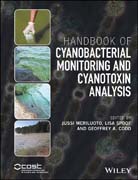
Handbook of Cyanobacterial Monitoring and Cyanotoxin Analysis
Meriluoto, Jussi
Spoof, Lisa
Codd, Geoffrey
A valuable handbook containing reviews, preactical methodsand standard operating procedures. A valuable and practical working handbook containing introductory and specialist content that tackles a major and growing field of environmental, microbiological and ecotoxicological monitoring and analysis Includes introductory reviews, practical analytical chapters and a comprehensive listing of almost thirty Standard Operating Procedures (SOPs) For use in the laboratory, in academic and government institutions and industrial settings INDICE: Notes on contributors .Preface .Acknowledgements .Section I. Introduction .1 Introduction: cyanobacteria, cyanotoxins, their human impact and risk management .Section II. Cyanobacteria .2 Ecology of cyanobacteria .3 Picocyanobacteria the smallest cell–size cyanobacteria .4 Expansion of alien and invasive cyanobacteria .Section III. Sampling, monitoring and risk management .5 Health and safety during sampling and in the laboratory .6 Basic guide to detection and monitoring of potentially toxic cyanobacteria .7 Case studies of environmental sampling, detection and monitoring of potentially toxic cyanobacteria .8 New tools for the monitoring of cyanobacteria in freshwater ecosystems .9 Remote sensing of cyanobacterial blooms in inland, coastal and ocean waters .10 The Italian system for cyanobacterial risk management in drinking water chains .Section IV. Toxins and bioactive/noxious compounds from cyanobacteria .11 Microcystins and nodularins .12 Cylindrospermopsin and congeners .13 Anatoxin–a, homoanatoxin–a and natural analogs .14 Saxitoxin and analogues .15 Anatoxin–a(S) .16 BMAA and DAB .17 Lipopolysaccharide (LPS) endotoxins .18 Cyanobacterial retinoids .19 Other cyanobacterial bioactive substances .20 Taste and odour compounds produced by cyanobacteria .Section V. Screening and trace analysis of cyanotoxins .21 Determination of cyanotoxins by HPLC–PDA .22 Determination of cyanotoxins by HPLC–FLD .23 Liquid chromatography mass spectrometry .24 Capillary electrophoresis of cyanobacterial toxins .25 Immunoassays and other antibody applications .26 Protein phosphatase inhibition assays .27 Bioassay use in the field of toxic cyanobacteria .28 Molecular tools for the detection of toxigenic cyanobacteria in natural ecosystems .Section VI. Methodological considerations .29 Method validation guidelines for the analysis of cyanotoxins .30 Interpretation, significance and reporting of results .31 Lessons from the U ice case: how to complement analytical data .32 Selection of analytical methodology for cyanotoxin analysis .Section VII. Standard Operating Procedures (SOPs) .SOP1 Cyanobacterial samples: preservation, enumeration and biovolume measurements .SOP2 Chlorophyll a extraction and determination .SOP3 Phycocyanin extraction and determination .SOP4 Analysis of picocyanobacteria abundance in epifluorescence microscopy .SOP5 Estimation of cyanobacteria biomass by marker pigment analysis .SOP6 Extraction of cyanotoxins from cyanobacterial biomass .SOP7 Solid phase extraction of microcystins and nodularin from drinking water .SOP8 Extraction of microcystins from animal tissues .SOP9 Analysis of microcystins by on–line solid phase extraction–liquid chromatography tandem mass spectrometry .SOP10 Determination of microcystins and nodularin in filtered and drinking water by LC–MS/MS .SOP11 Analysis of microcystins and nodularin by ultra high performance liquid chromatography tandem mass spectrometry (UHPLC–MS/MS) .SOP12 Analysis of microcystins in animal tissues using LC–MS/MS .SOP13 Quantitative screening of microcystins and nodularin in water samples with commercially available ELISA kits .SOP14 Quantitative screening of microcystins and nodularin in water samples with commercially available PPIA kits .SOP15 Solid phase extraction of cylindrospermopsin from filtered and drinking water .SOP16 Determination of cylindrospermopsin in filtered and drinking water by LC–MS/MS .SOP17 Solid phase extraction of anatoxin–a from filtered and drinking water .SOP18 Determination of anatoxin–a in filtered and drinking water by LC–MS/MS .SOP19 Analysis of anatoxin–a and cylindrospermopsin by ultra high performance LC/MS spectrometry .SOP20 Extraction and chemical analysis of saxitoxin and analoques in water .SOP21 Extraction of BMAA from cyanobacteria .SOP22 Analysis of BMAA by UHPLC–MS/MS .SOP23 Extraction and LC–MS/MS analysis of underivatised BMAA .SOP24 Extraction, purification and testing of LPS from cyanobacterial samples .SOP25 Extraction and chemical analysis of planktopeptin and anabaenopeptins .SOP26 Thamnocephalus test .SOP27 Determination of geosmin and 2–methylisoborneol in water by HS – SPME – GC/MS .SOP28 Rapid analysis of geosmin and 2–methylisoborneol from aqueous samples using solid phase extraction and GC–MS .SOP29 Basic validation protocol for the analysis of cyanotoxins in environmental samples .Section VIII. Appendices .Appendix 1 Cyanobacterial species and recent synonyms .Appendix 2 Cyanobacteria associated with the production of cyanotoxins .Appendix 3 Tables of microcystins and nodularins .Index
- ISBN: 978-1-119-06868-6
- Editorial: Wiley–Blackwell
- Encuadernacion: Cartoné
- Páginas: 592
- Fecha Publicación: 16/12/2016
- Nº Volúmenes: 1
- Idioma: Inglés
